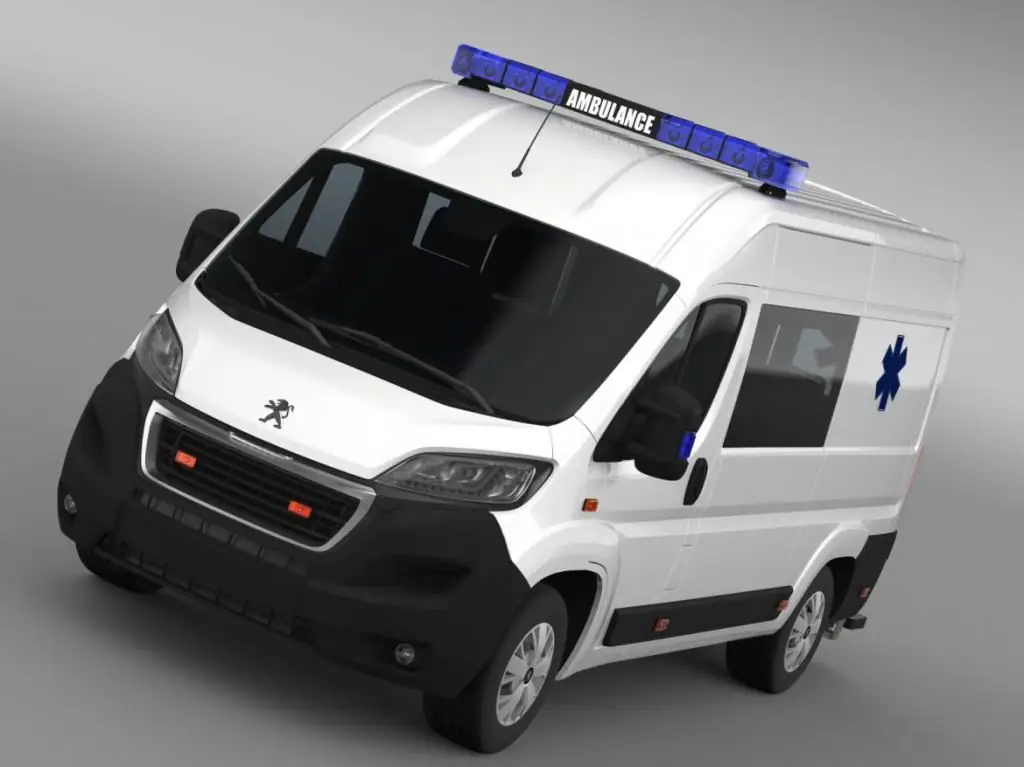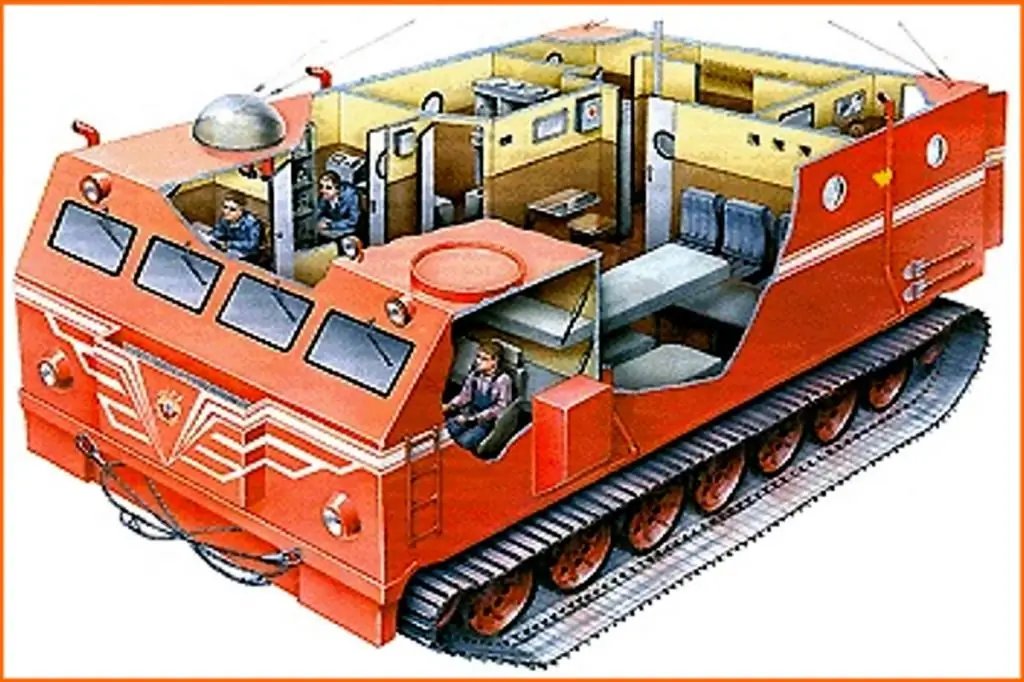2025 Author: Erin Ralphs | [email protected]. Last modified: 2025-01-22 21:14:09
In the 50s of the last century, Soviet polar explorers began active exploration of the Antarctic. For these purposes, special reliable transport was required, since the available equipment could not withstand the harsh operating conditions. The first machine that met these requirements, could work at extremely low temperatures, was the Kharkivchanka all-terrain vehicle. Consider the features and characteristics of this technique.

History of Creation
Separately, it is worth noting the predecessor of the machine in question. In 1957, the Penguin swamp was developed and quickly created, based on the base of the PT-76 tank. This representative of off-road equipment was of great help in the development of the Antarctic expanses. The unit proved to be a reliable machine with a decent running resource. But there were two significant drawbacks in its design: it was not intended to travel long distances and was cramped inside.
All-terrain vehicle "Kharkovchanka"lost those disadvantages. The car became more comfortable and spacious, which made it possible to send large groups of people who spent a long time on the road to transatlantic expeditions. Some experts compare the machine to a snow cruiser geared towards polar climates.
Description
The new machine was built as part of the "Product No. 404-C" project. The creation of equipment took place at the transport construction plant in Kharkov. The heavy tractor AT-T, intended for the needs of artillery, was taken as the basis for the design. Its base was increased by a couple of rollers, the frame turned out to be hollow and completely sealed. In its frontal part, a diesel power unit with 12 cylinders was placed. A five-speed gearbox, oil reservoirs, controls and a main fuel tank were also placed there.

The other eight fuel tanks of the Kharkivchanka all-terrain vehicle were installed in the middle frame compartment. Their total capacity was 2.5 thousand liters. At the back, heaters with a capacity of 200 cubic meters of hot air per hour, as well as a powerful hundred-meter winch, were mounted. As a result, the overall layout of large parts under the floor made it possible to free up more space for passenger modules and significantly reduce the center of gravity of equipment, the total height of which reached almost four meters.
Design and equipment
The dimensions of the Arctic all-terrain vehicle "Kharkovchanka" are impressive. The length of the vehicle was 8500 millimeters, and the width was 3500 mm. The rectangular one-volume body inside was equipped with a room with a total area of 28 "squares" with a ceiling height of 2.1 m. Such dimensions made it possible for the team to move freely around the cabin. The specified area was carefully isolated from the running block, had serious insulation and was divided into special compartments.
Inside the all-terrain vehicle "Kharkovchanka", in the frontal part above the engine, a control room was provided, where the navigator and the driver worked. On the right side (in the direction of travel) a radio headquarters was equipped, which was equipped with the most modern equipment at that time. Behind the partition on the left there was a sleeping room for eight people, and behind it - a wardroom. The layout even provided for the arrangement of the kitchen (galley). However, it was not suitable for full-fledged cooking, more often it was used to heat canned food. Behind this compartment, a heated toilet was equipped. The design features of the machine included the presence of a small clothes dryer, as well as a vestibule, which made it possible not to cool the air during landing and exit.

Operation
Since the Antarctic all-terrain vehicle "Kharkovchanka" was intended for operation in conditions of loose snow, and its composition is not inferior in hardness to sand, forming "quicksands", the designers made a serious revision of the tracks. To prevent the elements from sinking from the slightest contact with snow layers, their width became 1000 millimeters, while a snow hook was equipped on each track.
This decision made it possible to increasetractive effort, allowing the car to literally bite into the crust. The hooks have additional functionality. They helped the technique to overcome water obstacles if necessary. Despite the fact that the Kharkivchanka all-terrain vehicle did not belong to the class of amphibians, it could easily swim a certain distance through the water. Here it was necessary to show special care to the driver and navigator, making sure that the car did not sink below the floor level. The buoyancy parameter was provided by a hollow and sealed frame.

About the engine
The following are the main parameters of the power unit that set the specified equipment in motion:
- power rating at par - 520 "horses";
- the presence of turbine superchargers to double the power;
- fuel type - diesel fuel;
- working/maximum speed - 15/30 km/h.
The motor of the Kharkivchanka Antarctic all-terrain vehicle (see photo below) easily transported the car's own weight (about 35 tons), and also made it possible to tow a trailer weighing up to 70 tons. Most often, these were containers with fuel, since in such expeditions it is the most important cargo. Its part among the total volume was about 70%. It is worth noting that as part of the sleigh train, the speed was about 12-15 km/h.

Design features
From the nuances of the design, it should be emphasized the presencemoisture absorbers with a constant influx of hot air masses. This made it possible to avoid possible freezing of the windows. Electric heating was provided on the windshields, similar to modern automotive analogues. The generator of the machine in question was capable of generating about 13 kilowatts of electricity per hour. This was quite enough for the needs of the expedition members.
Judging by the reviews, thanks to the unique layout, the Kharkivchanka all-terrain vehicle in the first generation was in operation for quite a long time (until 2008), and some models still serve. The second generation of this technique appeared already in 1975 and was equipped with a separate residential module. The features of this machine will be discussed below.
As for "Kharkovchanka-1", the operation of these modifications indicates that it is convenient to service the engine without leaving the passenger compartment. Nevertheless, it was not possible to completely level out the exhaust gases breaking inward. And this significantly reduced the comfort of staying in the living compartment. The thermal insulation of the first versions was also not at the highest level.

Second Generation
The first generation of the considered all-terrain vehicle was quite reliable, but did not meet modern requirements. In this regard, the Kharkov plant in 1974 received a new order for five improved machines. Taking into account the operating experience and recommendations of the polar explorers, the designers made certain adjustments to the design and life support system of the equipment. The updated unit was called "Kharkovchanka-2". speci althe complexity for the engineers was presented by the modernization of the residential part. It was also necessary to equip the complex with radio navigation software.
As a result, they have achieved a comfortable microclimate inside, despite the strength of the frost outside. Even with a system failure, the temperature in the cabin dropped by no more than 3 degrees per day. The implementation of this solution became possible due to the use of modern thermal insulation materials. The engine hood and driver's cab remained the traditional configuration. At the same time, the residential part was transferred to an elongated cargo platform. Taking into account the recommendations of the polar explorers, the developers at the last moment made a window for ventilation. This innovation was equipped literally before sending the updated machines to Antarctica. The all-terrain vehicle "Kharkovchanka" in the late 80s received another restyling with a base in the form of an MT-T tractor, but after the collapse of the USSR, the project was never implemented.

Result
Judging by the reviews, this technique is still functioning. Moreover, some experts are convinced that there is no better car in their segment. This fact is confirmed by the fact that in 1967 the expedition reached the most remote point of the South Pole and returned without any problems. No one else has visited this part of the Earth since Kharkiv Women.
Recommended:
"Peugeot Boxer": dimensions, technical characteristics, declared power, maximum speed, operating features and owner reviews

Dimension "Peugeot-Boxer" and other technical characteristics. Car "Peugeot Boxer": body, modifications, power, speed, features of operation. Owner reviews about the passenger version of the car and other models
Honda PC 800: specifications, declared power, maximum speed, operating features and owner reviews

The Honda PC800 touring motorcycle is the best option for long trips and maneuvering in dense city traffic. The model is unpretentious in maintenance, has unsurpassed reliability and high build quality
"Ford Mondeo" (diesel): technical specifications, equipment, operating features, owner reviews about the advantages and disadvantages of the car

Ford is the world's largest automobile manufacturer. Although the main production facilities are located in the United States, Ford cars are quite common on Russian roads. The company is in the top three in the production of cars after Toyota and General Motors. The most popular cars are Ford Focus and Mondeo, which will be discussed in this article
"Nissan Qashqai": performance characteristics, types, classification, fuel consumption, declared power, maximum speed, operating features and owner reviews

In March of this year, the premiere of the updated Nissan Qashqai 2018 model took place at the Geneva International Motor Show. It is planned to enter the European market in July-August 2018. The Japanese came up with the ProPilot 1.0 supercomputer to facilitate the management of the new Nissan Qashqai 2018
"Toyota RAV4" (diesel): technical specifications, equipment, declared power, operating features and reviews of car owners

The Japanese-made car Toyota RAV4 (diesel) is rightfully in the lead among the most popular crossovers in the world. Moreover, this car is equally highly valued on various continents. At the same time, this car is not the most technologically advanced in its segment; many European and American competitors bypass it. However, there is something unique and mesmerizing about it. Let's try to understand this in more detail

